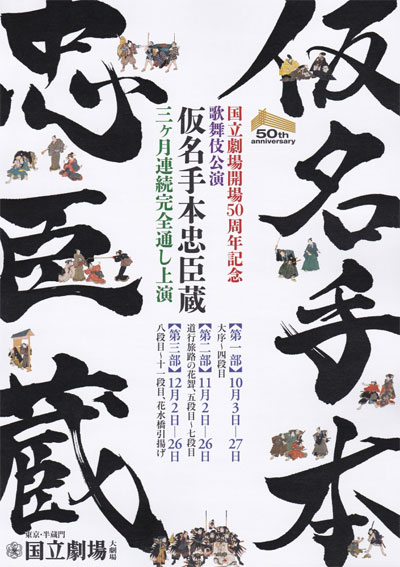| Comments |
The sanbusei tripartite system, which is usually used only in August,
is used in December as well!
The newly-created Kabuki drama "Arashi no Yoru ni", which was premiered in September 2015 in Ky˘to at the Minamiza [more details], is staged for the first time in T˘ky˘ with almost the same casting.
The highlights of the second program is "Terakoya" with Nakamura Kankur˘, Nakamura Shichinosuke, Onoe Matsuya and Nakamura Baishi in the roles of Matsu˘maru, Chiyo, Genz˘ and Tonami.
The star of the third program is Living National Treasure Band˘ Tamasabur˘, who performs in "Ninin Wankyű" and in a special version of "Musume D˘j˘ji" with 5 shiraby˘shi.
Arashi no Yoru ni: it is a series of picture books written by Kimura Yűichi.
The first edition was published in 1994. As many people wanted to read a sequel to the story,
it lasted to the seventh volume and became a best seller. More than 3,000,000 books have been sold.
It became so popular that it has been turned into a game and made into plays.
In 2005, it was made into an animated movie (the voice for the main character Gabu was supplied by Nakamura Shid˘)
by Sugii Gisabur˘, an esteemed movie producer in the animation industry.
It was adapted to Kabuki for the first time in September 2015 in Ky˘to at the Minamiza.
On the night of a storm, a wolf Gabu (Nakamura Shid˘) and a goat Mei (Onoe Matsuya) encounters in a mountain hut
in pitch darkness by chance. They talk through night not knowing their identity and become friends.
They determine their password as 'On the night of a storm' and promise to meet again.
They are shocked when they meet again, but they nurture friendship keeping it secret to their each group.
But their friendship is at last known to both groups and meets with violent opposition.
The two are pushed to the edge ... Featuring Kawarasaki Gonjűr˘, Ichimura Manjir˘, Ichikawa En'ya and Ichikawa Chűsha.
Fubuki T˘ge: Oen and Sukez˘, an adulterous couple, have to take refuge
in a mountain hut built for pilgrims because of a violent snow storm.
Oen was the wife of the gambler Naokichi, who was Sukez˘'s boss. They fell in love
and, in order to escape death (a normal punishment for their immoral conduct),
they had to elope. They now live as fugitives, in great fear of revenge by Naokichi.
Fate has something in store for them as, this very night, Naokichi, who goes on
pilgrimage, turns up and an interesting encounter takes place.
A play by the modern playwright Uno Nobuo that shows the characters in a complex
love relationship all thrown together in a house on a mountain pass in a snowstorm.
Featuring Ichikawa Chűsha, Nakamura Shichinosuke and Onoe Matsuya in the roles of Naokichi, Oen and Sukez˘.
Terakoya: Genz˘ and his wife Tonami run a small school and are
protecting Kan Sh˘j˘'s son and heir, saying that he is their son. However,
word has gotten out Kan Sh˘j˘'s son is there and Genz˘ has been ordered to
behead him. Moreover, Matsu˘maru is to come to inspect the head. Their only
alternative is to kill one of the other students as a substitute, but all of
the students are farmer's children who could never pass for the son of a court
aristocrat. However, a new boy arrives that day and Genz˘ makes the terrible
decision to kill him in the place of his lord. As it turns out, Matsu˘maru has
sent his own son to be sacrificed, because of his family's long loyalty to
Kan Sh˘j˘. But he must face the most terrible situation for a father,
inspecting the head of his own son and lying when he says that it is the
genuine head of the son of Kan Sh˘j˘. Finally Matsu˘maru reveals his true
feelings to Genz˘ and he and his wife Chiyo mourn their dead son.
Starring Nakamura Kankur˘ as Matsu˘maru, Onoe Matsuya as Genz˘, Nakamura Shichinosuke as Chiyo and Nakamura Baishi as Tonami.
Featuring also Ichikawa En'ya as Shund˘ Genba.
Ninin Wankyű: the fabulously wealthy Wan'ya Kyűbŕ (nicknamed Wankyű) is disowned by
his family for falling in love with the courtesan Matsuyama.
Then, when she dies, he goes mad with grief and wanders through the countryside.
This dance shows him as he imagines meeting Matsuyama again and there is a
lively dance recalling their happiness together before the vision fades
and he is left alone. Starring Nakamura Kankur˘ as Wankyű and Living National Treasure Band˘ Tamasabur˘ as Matsuyama.
Gonin D˘j˘ji: this is a variation of "Ky˘ganoko Musume D˘j˘ji"
which was adapted from a N˘ play "D˘j˘ji".
"Ky˘ganoko Musume D˘j˘ji" is the most famous of all Kabuki dances and
considered to be the pinnacle of the art of the onnagata female role specialist.
There was a young woman called Princess Kiyo who had fallen in love with a monk. The monk soon left her and
knowing this betrayal, she changed into a snake from jealousy. The snake followed him, and coiling itself
around the bell of the D˘j˘ji temple it burned him and itself to death.
A few years later, a new bell was made for the D˘j˘ji temple, and the
dedication ceremony was being held. A woman suddenly appeared and asked to have a look at the new bell.
D˘j˘ji temple was closed to women ever since Princess Kiyo's incident,
but promising to dance for the ceremony, she was admitted to enter. She danced a beautiful dance
representing many aspects of a woman in love. However, she is actually the spirit of Princess Kiyo
hoping to destroy the bell again. In the original "Ky˘ganoko Musume D˘j˘ji",
the woman is played by one actor and the actor dances the whole dancing part but in this special version,
5 actors will be playing the woman and dance the dancing part. Starring Living National Treasure Band˘ Tamasabur˘, Nakamura Kankur˘, Nakamura Shichinosuke, Nakamura Baishi and Nakamura Kotar˘.
Sources: Earphone Guide Website or Sh˘chiku Kabuki Official Website
|





